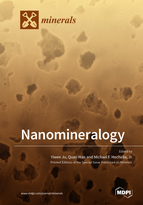Nanomineralogy
A special issue of Minerals (ISSN 2075-163X). This special issue belongs to the section "Crystallography and Physical Chemistry of Minerals & Nanominerals".
Deadline for manuscript submissions: closed (30 April 2019) | Viewed by 72371
Special Issue Editors
Interests: nanogeoscience; structural geology; unconventional energy geology; coal; shale; gas geology; ore deposits; basin geology
Interests: nanogeoscience; mineralogy; experimental geochemistry; (nano)materials science; polymer chemistry and physics
Special Issues, Collections and Topics in MDPI journals
Interests: nanogeoscience; mineral surface geochemistry; biogeochemistry; environmental science; mineral–microbe interactions
Special Issue Information
Dear Colleagues,
The 2018 International Conference on Nanogeosciences was held in Guiyang, China between June 22nd and 27th, 2018. Researchers from around the world gathered together and actively discussed emerging challenges and opportunities in numerous fields of nanogeosciences. This Special Issue of Minerals aims to showcase recent advances in the wide range of themes in nanogeosciences, with a substantial focus on the nanoscale research in mineralogy. We invite attendees of the nanogeosciences conference to submit selected high quality manuscripts to this Special Issue. Suitable contributions from other interested professionals are also welcome.
The first round submission deadline is: 31 March 2019
Prof. Dr. Yiwen Ju
Prof. Dr. Quan Wan
Prof. Dr. Michael F. Hochella, Jr.
Guest Editors
Manuscript Submission Information
Manuscripts should be submitted online at www.mdpi.com by registering and logging in to this website. Once you are registered, click here to go to the submission form. Manuscripts can be submitted until the deadline. All submissions that pass pre-check are peer-reviewed. Accepted papers will be published continuously in the journal (as soon as accepted) and will be listed together on the special issue website. Research articles, review articles as well as short communications are invited. For planned papers, a title and short abstract (about 100 words) can be sent to the Editorial Office for announcement on this website.
Submitted manuscripts should not have been published previously, nor be under consideration for publication elsewhere (except conference proceedings papers). All manuscripts are thoroughly refereed through a single-blind peer-review process. A guide for authors and other relevant information for submission of manuscripts is available on the Instructions for Authors page. Minerals is an international peer-reviewed open access monthly journal published by MDPI.
Please visit the Instructions for Authors page before submitting a manuscript. The Article Processing Charge (APC) for publication in this open access journal is 2400 CHF (Swiss Francs). Submitted papers should be well formatted and use good English. Authors may use MDPI's English editing service prior to publication or during author revisions.
Keywords
- Nanogeoscience
- Nanomineralogy
- Nanominerals
- Mineral nanoparticles
- Nanopores
- Nanogeochemistry
- Mineral–water interface







